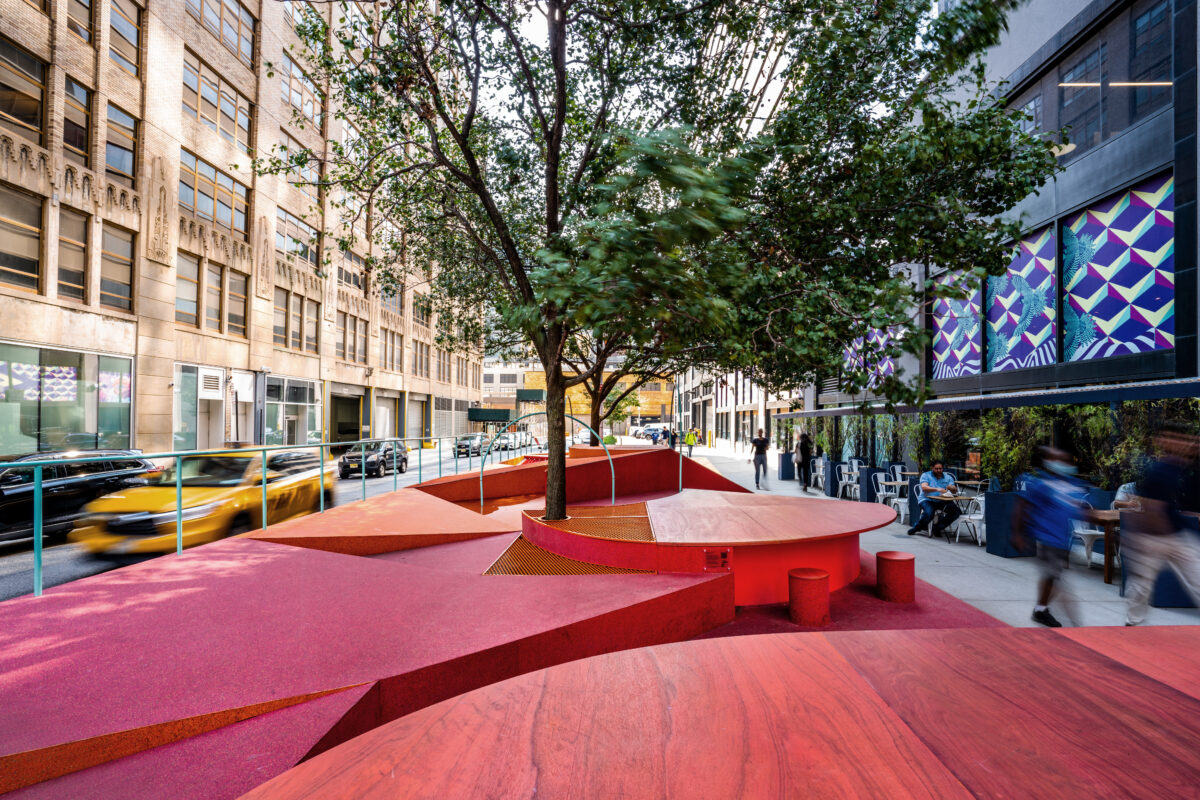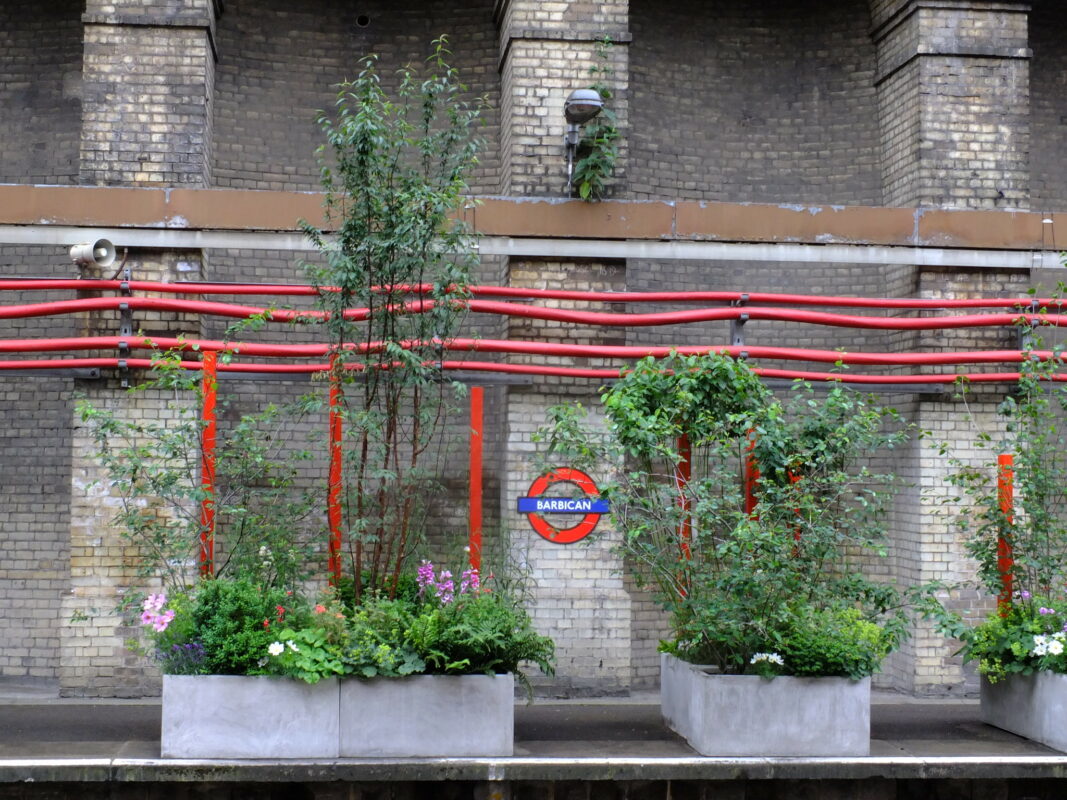
BACKGROUND
The pandemic has left a lasting imprint on all New Yorkers, with loss and disconnection deeply ingrained in the city’s collective memory. Traumatic events like these – both collective and individual – can have long-term impacts on a person’s physical and mental health. For instance, people who experience childhood trauma are more likely to experience loneliness in adulthood. In turn, social disconnection increases risks of hypertension, depression and anxiety, cardiovascular disease, and diabetes. For veterans, asylum seekers, survivors of gun violence, and other New Yorkers that have experienced trauma, environments can often be triggering or re-traumatizing. Harsh lighting, loud noises, or the condition and quality of public spaces have major implications on New Yorkers’ perceptions of safety and stress levels.
VISION
New York City must prioritize healing and belonging by implementing a comprehensive transformation of the public realm design process. Drawing inspiration from American psychiatrist Judith Herman’s influential work Trauma and Recovery, a new design framework could prioritize principles of trauma-informed care: safety, choice, and community. To ensure mental health is at the forefront of every planning process, the City should appoint a dedicated advocate for New Yorkers with diverse mental health needs. Equitable allocation of resources in programming and community public space stewardship can play a crucial role in reshaping existing civic spaces to foster social cohesion and unlock the broader health benefits that accompany it.
IDEAS
Create elevated design guidelines for civic spaces that are grounded in principles of compassion and care.
Although there is growing attention to the impact of public space design on wellness, direct design guidance on the impacts of lighting, architecture, or streetscape design on mental health is limited. The City could ground new approaches in three principles: spaces should feel safe and welcoming; spaces should allow New Yorkers to express themselves and their experiences openly and freely without stigma; and spaces should support connections to others.
In order to develop and encourage these principles, approaches could include the following:
54.
Appoint a champion or champions in city government that can deepen connections across agencies, with a focus on centering care and healing into the design civic spaces in neighborhoods with a history of trauma or underinvestment.
55.
Convene the Public Design Commission (PDC), Department of City Planning (DCP), Department of Housing Preservation and Development (HPD), Department of Health and Mental Hygiene (DOHMH), and supportive housing architects and developers to study trauma-informed design for residential projects. Look to existing studies led by Shopworks Architecture’s Architectural Principles in the Service of Trauma-informed Design.
56.
Under the leadership of the Chief Public Realm Officer, build on NYC’s Active Design Guidelines and Streetscapes for Wellness to develop a manual that roots trauma-informed care principles of safety, choice, and community for new design and programming at the Department of Parks & Recreation (DPR) and Department of Transportation (DOT).
Case Study:
Shopworks Architecture’s Architectural Principles in the Service of Trauma-informed Design
Denver-based Shopworks Architecture has developed a framework for trauma-informed design of buildings to help regulate the body and support therapeutic approaches. Developed with scholars and practitioners in the fields of architecture, sociology, engineering, and non-profit service, as well as residents and organizations, these principles have guided the design of shelters and supportive housing.
Foster tactical public realm projects in underutilized sites that could support both respite and social connections.
New Yorkers facing stress, anxiety, or re-traumatization in public spaces often lack the choice to relocate based on their preferred level of social, physical, and sensory engagement. Designing flexible and distinctive options for users can ensure public space is inclusive to all.
Tools and approaches to expand these types of spaces to every neighborhood could include:
57.
Lower barriers and increase funding for community-led public space interventions tied to addressing mental health challenges in neighborhoods experiencing historic disinvestment. Community-led projects could include alternative uses for curb space, expansion of Open Streets programming, vacant lots, and activation of underutilized city properties. Build on projects like the Design Trust’s Under the Elevated initiative, Project Eats, or El Jardin del Paraiso that can support greater connectivity in the urban fabric as well as quiet spaces for respite.
58.
Provide outreach funding to community partners to help increase community-led public space programming and planning, modeled by DOT’s BQE Corridor Vision Community Partners program. plazas for health and wellness programming.
59.
DOT and DPR could launch a toolkit for low-cost community-led social seating in the right of way. Benches around street trees, for example, could encourage greater connections and environmental stewardship. Neighborhood anchors (like libraries and schools), Business Improvement Districts, and property owners could look to previous projects such as WIP Collaborative’s Restorative Ground DOT Street Seat for micro- and tactical public space activation.
60.
Support faith-based development of underutilized land into affordable homes and community facilities. Programs led by faith-based organizations could support neighborhood social cohesion through programming and provide social services.
61.
Invest in Caring Kiosks in neighborhoods with high rates of stress, depression, and substance use to increase access, proximity, and visibility to integral health services. These can range from permanent to pop-up kiosks with partners like DOHMH, Business Improvement Districts and other community-based organizations, and NYC Health + Hospitals’ Street Health Outreach & Wellness programs mobile units. The City could pilot projects modeled off Times Square Alliance’s Recharge Stations or invest in permanent park infrastructure like the Deliveristas Hub that retrofits underutilized or vacant newsstands.
Case Study:
Restorative Ground

Image Credit: Courtesy of WIP Collaborative and Hudson Square Properties, photo by Sam Lahoz.
Designed by WIP Collaborative and activated through the Department of Transportation’s street seat program, this tactical streetscape installation was guided by principles of immersion and mental health inclusivity. The project sought to make recreational space that met distinct neurological needs. The project was supported by a collaboration between Urban Design Forum, Hudson Square Properties, and Hudson Square BID.
Launch a transportation initiative grounded in biophilic art and design.
Public health research increasingly shows the long-term negative impacts of city noise on heart and brain health. Conversely, data increasingly shows the benefits nature has on overall health. To mitigate the negative impacts of traffic related noise and other sensory impacts, like harsh lighting, the City should explore new biophilic urban design investments in our transportation network.
Multiple strategies to improve areas around transportation corridors could include the following:
62.
In partnership with neurodiversity advocates and other groups raising awareness of sound sensitivity, the City could launch a design competition to explore short-term and long-term design interventions that mitigate noise through green space and blue space, such as fountains, water features, or greater vegetation. Small scale interventions could model after Transport for London’s Underground in Bloom competition. that showcases the talents of green-thumbed agency staff across different city stations.
63.
Leverage advertising, experiential marketing, and corporate partnerships to drive biophilic art and design competitions and pilots across indoor and outdoor transit stations.
64.
Develop a community stewardship program that provides license agreements to CBOs to maintain gardens on Metropolitan Transportation Authority (MTA), New York City Transit, and New York City and New York State DOT properties or lots beneath elevated tracks, building on past initiatives like Under the Elevated.
65.
Develop more rigorous design review of new Metropolitan Transportation Authority (MTA) stations in order to prioritize natural light or mood stabilizing light, nature or natural analogues in stations, and principles of biophilic design. Model after The Metro Tunnel Project in Melbourne, which uses biophilic design principles to create an enjoyable and engaging experience for commuters.
66.
Fund and expand MTA Arts & Design commissions at stations in neighborhoods with the highest rates of depression and anxiety, through partnerships with community arts and health organizations.
67.
Partner with research institutions to study transit-related noise impacts on health to guide future design improvements and interventions.
68.
Invite creative community installations that visualize sound monitoring near major transportation corridors to support citizen science.
Case Study:
Transport for London Greening Initiatives

Image Credit: B via Flickr
The small-scale greening interventions as part of Transport for London’s Underground in Bloom competition showcases the talents of green-thumbed agency staff across different city stations. In 2015, London Underground (LU) launched its first ever pop-up garden at Barbican Tube station. The garden was created in partnership with the Friends of City Gardens and stewarded by neighborhood volunteers.
Invest in social programs that support stronger community cohesion and healing.
According to the US Surgeon General, investing in social infrastructure, like libraries and parks, can significantly support social connections and lower the odds of depression in people that have experienced historic trauma. Arts and other cultural programming could serve as a vehicle for helping New Yorkers process the experiences of trauma or loneliness.
Programs to advance this could include the following:
69.
Invest in programs led by local arts or faith-based organizations that have community ties and convening space, as a way of strengthening community cohesion to fight loneliness.
70.
Invest in intergenerational walking groups, building off of DPR’s Walk to the Park initiative.
71.
Expand Public Artists in Residence (PAIR) program, especially in agencies that interface with communities experiencing high rates of chronic disease. The City can build on previous art activation models and partnerships like DOT and DOH’s “Concrete Connection” mural in the South Bronx.
72.
Through the DPR’s Community Parks Initiative and DOHMH, drive new funding to support local artists-in-residence that lead programming dedicated to healing and wellness at existing parks facilities.
73.
With DOT, partner with community organizations to organize temporary events focused on community healing to reclaim public spaces, like plazas and streets. Providing micro-grants and permit technical assistance can support smaller activations by grassroots organizations in the most vulnerable neighborhoods.
Many thanks to the Spaces For Healing Working Group members, who collaborated on the creation of these ideas and recommendations: Sara Eldridge, Laura Nova, Julie Chou, Amy Pivak, Rachel Ann Simpson and Barrett Feldman.